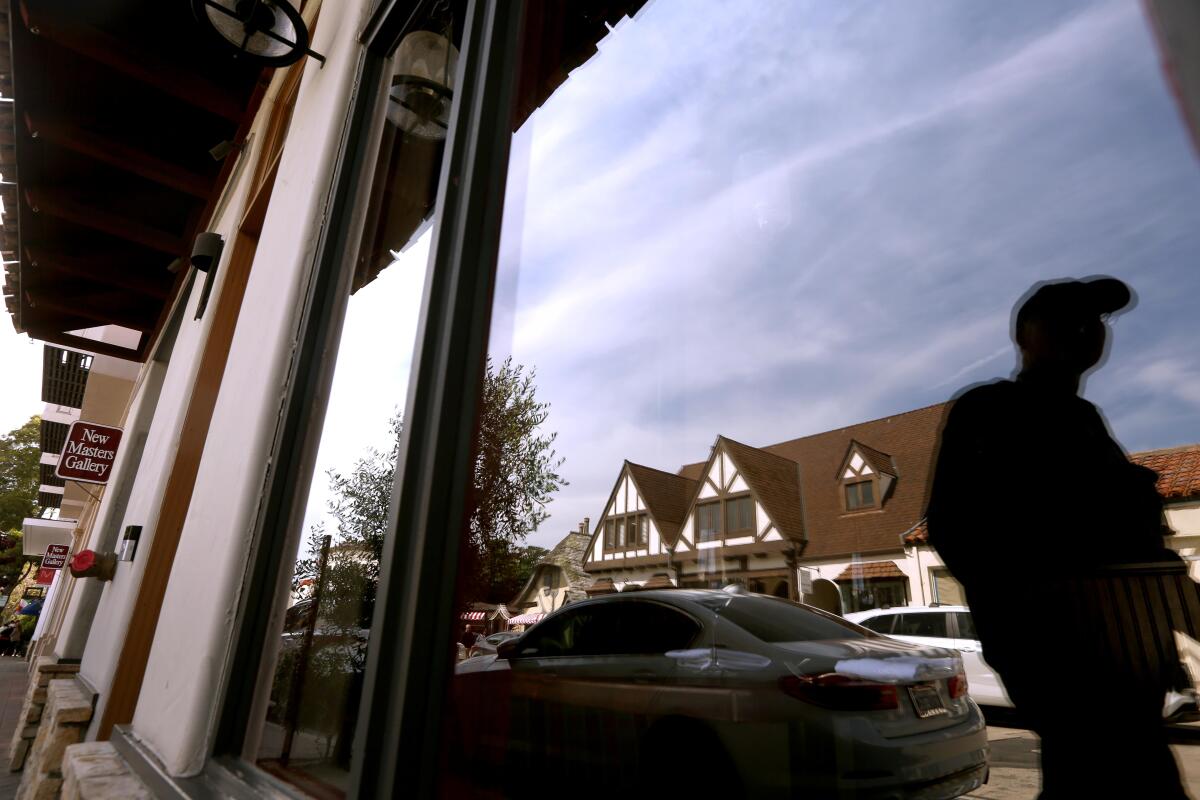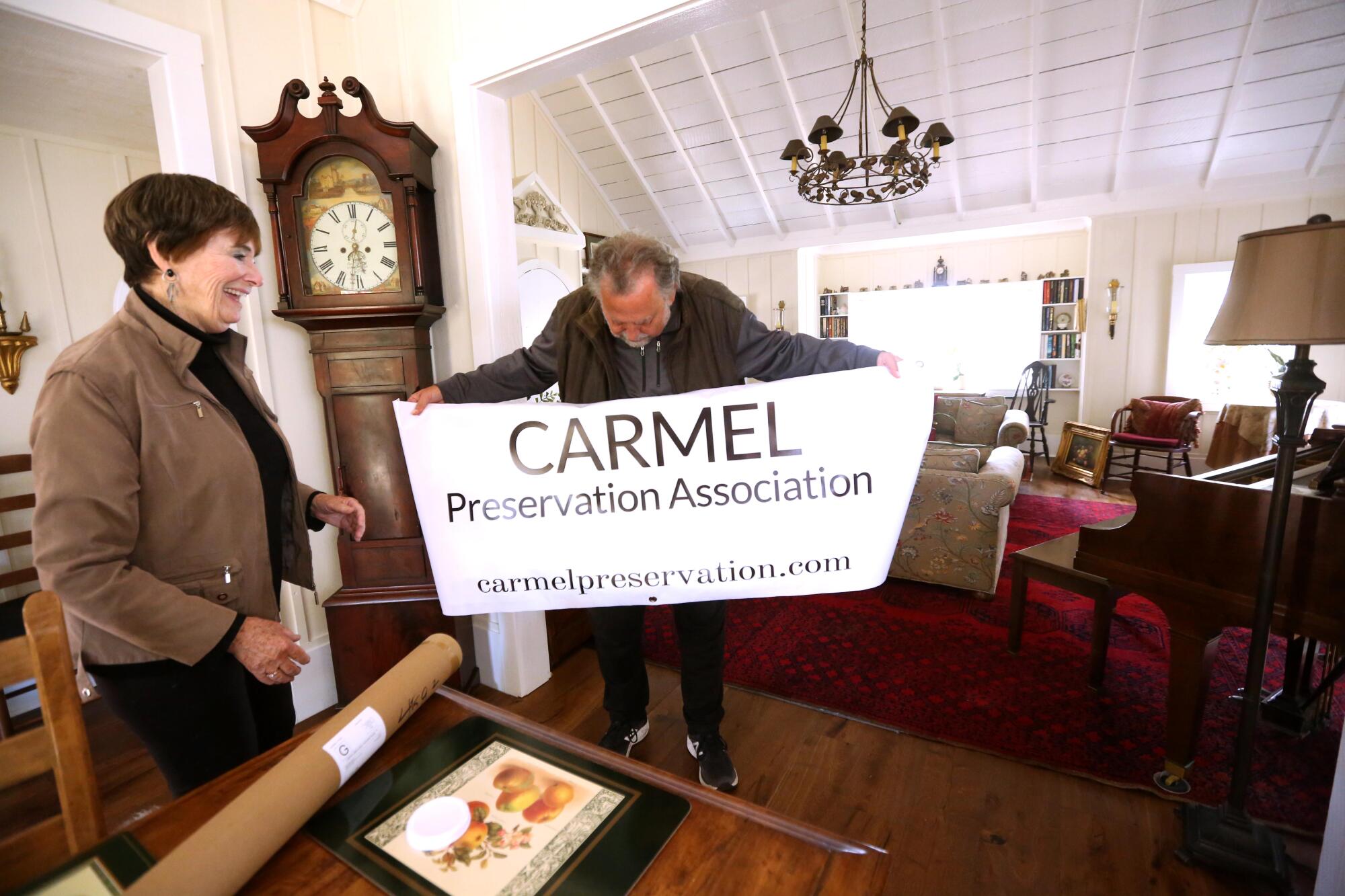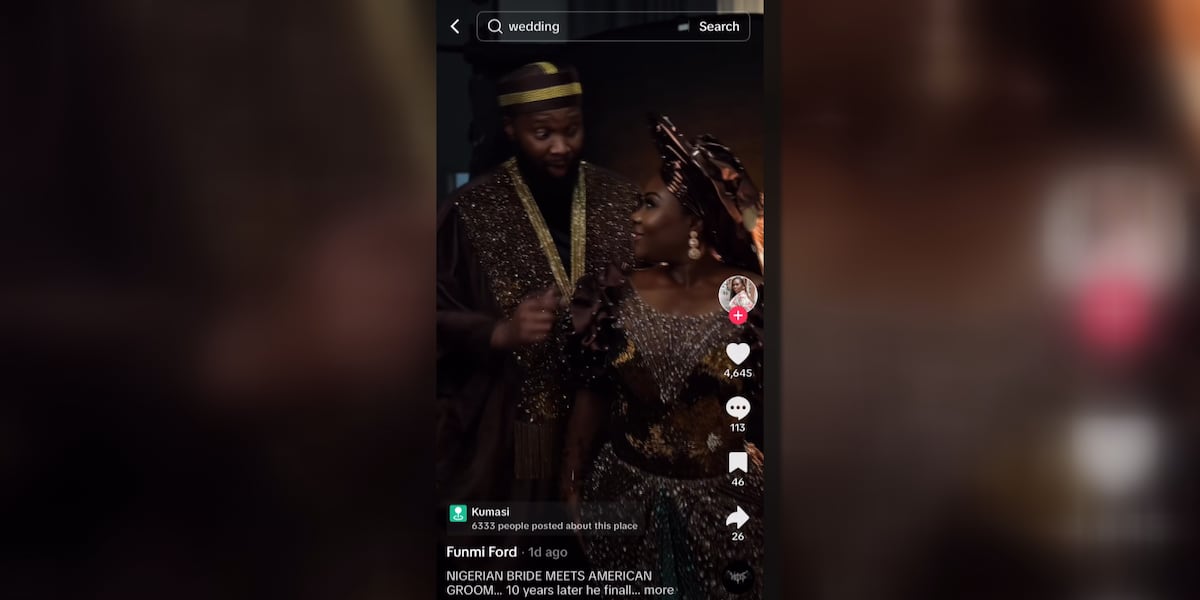Business
Why is a Monaco billionaire buying so many properties in Carmel and Big Sur?

People call it “The Pit.”
It’s a massive, unsightly hole in the ground — the site of a construction project in downtown Carmel-by-the-Sea whose previous owners ran out of money six years ago, leaving behind nothing but concrete, rebar and hard feelings.
In 2020, The Pit was purchased by Patrice Pastor, a billionaire real estate developer from the tiny European nation of Monaco, for $9 million.
Last year, he plopped down $22 million for a much prettier property: Cabin on the Rocks, the only oceanfront home ever designed by famed architect Frank Lloyd Wright.
Jeff Becom, president of the board of the Carmel Art Assn., stands next to the construction eyesore known as “The Pit” in Carmel-by-the-Sea.
And in mid-June, he got approval from the California Coastal Commission for his “visionary plan” to restore public access at Rocky Point, a seaside property he bought for $8 million in nearby Big Sur with views of the iconic Bixby Bridge.
Pastor has been on a buying spree in and around Carmel-by-the-Sea, dropping more than $100 million on at least 18 properties over the last decade. So much so that his presence has become a source of intrigue, and for some, downright suspicion, in this moneyed one-square-mile town of 3,200 people.
Pastor bought the Hog’s Breath Building, the site of the pub once owned by actor Clint Eastwood. He bought the L’Auberge Carmel hotel, which houses a Michelin star restaurant. He snapped up the Der Ling building, a 1924 shop, done in fairytale-style architecture next to a stone pathway leading to a hidden garden.
“When someone comes in with so much money and can use that money for influence on so many things, that’s … scary in any community,” said Dee Borsella, who owns a custom pajama shop across from The Pit. “Every person has the right to do this. But why is he picking Carmel?”
1

2

3

1. A visitor walks through the central courtyard of Der Ling Lane. 2. The Bingham Building on Dolores Street, reflected in a storefront window. 3. The Rocky Point Restaurant, one of the latest purchases by Monaco billionaire Patrice Pastor, rests on a bluff high above the Pacific Ocean in Big Sur.
Pastor is the scion of a powerful real estate family that built much of mega-rich Monaco, a dense, one-square-mile nation on the French Riviera.
He says he first came to Carmel-by-the-Sea at age 7 during a trip with his father, and that he had never seen his dad more relaxed. The memory stuck with him. He now owns multiple homes in town and visits several times a year.
“It’s not like he picked up a book one day and was like, ‘Let me find the best place to invest.’ It’s that he personally loves it here,’” said Claire Totten, a spokeswoman for Esperanza Carmel LLC, the local branch of his international real estate company.
Still, Pastor has created quite the buzz in this gracefully aging town where, according to Zillow, the typical home price is $2.2 million.
During a scuffle last summer, the city administrator took a swing at an art gallery owner who accused local officials of being xenophobic for slowing one of Pastor’s projects. And the billionaire’s local real estate portfolio burst into international headlines this year after an article by SF Gate quoted an anonymous business owner who said people were “terrified” of his intentions.
Soon afterward, Pastor showed up to a City Council meeting via Zoom and said he would “like to inform those who feel terrified by my presence” that he would be in town a few days later: “So I suggest they either take a vacation during this period or come and meet me for a relaxation class.”
Pastor — who, according to the French newspaper Le Monde, has squabbled over lucrative development contracts with associates of Monaco’s Prince Albert II — has more humble antagonists in Carmel-by-the-Sea: the City Council, the Planning Commission and the Historic Resources Board.
The city has rejected several of his design proposals, including two for The Pit.
Development — including upgrades to private homes — is notoriously slow here. The city strictly regulates architecture to maintain the so-called village character of this woodsy place. Carmel uses no street addresses (people give their homes whimsical names instead), and has no streetlights or sidewalks in residential areas.

The Mrs. Clinton Walker House is the the only oceanfront home designed by famed architect Frank Lloyd Wright.
Eastwood, who was mayor in the1980s, got involved in local politics after fighting with the City Council over what he said were unreasonable restrictions on the design of an office building he wanted to erect. Pastor now owns that building.
Pastor “loves that it’s a bit idiosyncratic,” Totten said. “Carmel is a little bit etched in time. The world moves on, but Carmel is still Carmel.”
Pastor’s local defenders question whether he is being discriminated against because he is too rich.
“He’s had a hard time with the city,” said Karyl Hall, co-chair of the Carmel Preservation Assn. “It’s one thing after another after another. They’ve just beaten him down incredibly.”
“There’s no question that he gets more scrutiny,” said Tim Allen, a real estate agent who has handled most of Pastor’s local purchases, including the Frank Lloyd Wright residence, also known as the Mrs. Clinton Walker House.
Completed in 1952 and listed on the National Register of Historic Places, the architectural jewel had been kept within the original owner’s family until Pastor bought it in February 2023. The 1,400-square-foot house, on a rocky bluff jutting into Carmel Bay, has a hexagonal living room and stone masonry walls shaped like a ship’s prow cutting through the waves.
In a 1945 letter to Wright, artist Della Walker wrote: “I am a woman living alone — I wish protection from the wind and privacy from the road and a house as enduring as the rocks but as transparent and charming as the waves and as delicate as a seashore. You are the only man who can do this — will you help me?”
The architect replied: “Dear Mrs. Walker: I liked your letter, brief and to the point.”

“There’s no question that he gets more scrutiny,” real estate agent Tim Allen says of Monaco billionaire Patrice Pastor, whose land purchases in Carmel-By-The-Sea have generated suspicion.
Allen said Pastor’s purchase includes the original furniture, because “he’s buying a piece of history” — albeit one that “needs a ton of work,” including an expensive new roof.
Last spring, Esperanza Carmel LLC, applied for a Mills Act contract for the site, a tax break for owners of historic properties who commit to restoring and preserving them. Although the City Council had approved such a contract for the home’s previous owner, some council members balked at giving the tax break — a saving of an estimated $1.5 million over 10 years — to Pastor and postponed a decision for several months.
One resident, in a letter to the City Council, wrote: “I doubt the applicant is in financial hardship … I’m not in favor of giving handouts to ultra wealthy property owners.”
Before the council approved the tax break this spring, city officials tried to persuade Pastor to give public tours of the house and to make direct payments to local schools (which are partly funded by property taxes) — requests not made of applicants for other properties. Pastor refused.
Via Zoom, Pastor told the council he would “maintain this wonderful house in perfect condition, even if only to continue to bother those jealous people who will never have access to it.”
City officials are waging another only-in-Carmel fight with Pastor over a mixed-use development and subterranean parking garage on Dolores Street that he has been trying to build for more than three years.
Plans submitted to the city in 2021 called for the demolition of a former bank annex once used as a community room. Because it was less than 50 years old, it did not qualify as a historic structure — but after it turned 50 in October 2022, the Carmel Historic Resources Board voted to add it to the city’s historic resources list.
Pastor agreed to build around the annex.
Then, another issue arose: The project would require the removal of a small concrete wall, decorated with exposed aggregate and inlaid rocks, built in 1972 by a man local historians dubbed the “father of stamped concrete.”
The City Council last fall said the wall was too important to be moved and sent Pastor’s company back to the drawing board.
Allen, the real estate agent, decried the delays as petty grievances. Pastor’s proposed developments, he said, will add apartments, parking and public restrooms — all of which are sorely needed.

Carmel-by-the-Sea relies on the tourists drawn to its cottages, courtyards and secret passageways.

Carmel-by-the-Sea strictly regulates development to maintain its village character. The city uses no street addresses. Instead, people give their homes whimsical names.
“He doesn’t just buy to terrorize people,” Allen said. “He buys because it’s a good investment.”
Mayor Dave Potter said it is tough for anybody to build here and that Pastor is being treated fairly.
“We pride ourselves on our uniqueness,” he said. “You don’t get to just come in and build whatever you want. We don’t care if you’re a movie star or a mega-millionaire. You have to play by the same rules everybody else does.”
Hall and Neal Kruse, co-chairs of the grassroots Carmel Preservation Assn., are adamant, if surprising, supporters of Pastor.
They believe modern architecture — which they describe as ‘Anywhere, USA’ buildings with sterile facades and box-like structures — poses an existential threat to Carmel-by-the-Sea, which depends on tourists drawn to its cottages, courtyards and secret passageways.
Hall, a retired research psychologist, said she talks regularly with Pastor, whom she described as “so nice, so charming and so heartfelt,” and noted that he has several modern-architecture projects in the works overseas.
“He said, ‘Karyl, you’d hate them,’” she said, laughing.
Hall and Kruse started the preservation association in response to the first proposal for The Pit, a contemporary design approved by the Planning Commission for the previous owners. They called that planned edifice “the ice box.”
Hall said they were heartened by Pastor, who proposed more traditional buildings for The Pit.
Longtime residents “remember Carmel, and we remember the sacredness of it and why people come here,” said Kruse, an architectural designer. “We’re the ones that are largely concerned about the loss of character. But Patrice played a central role in reassuring the residents that he would help that not happen.”

Karyl Hall, left, and Neal Kruse started the Carmel Preservation Assn. Longtime residents “remember Carmel, and we remember the sacredness of it and why people come here,” Kruse says.
Over more than two years, the Planning Commission rejected two Esperanza Carmel designs for The Pit before approving a third last August for a mixed-use project with apartments, stores and an underground parking garage. Construction has not yet begun.
The 91-year home of the Carmel Art Assn. — of which surrealist painter Salvador Dali was a member — is next door to The Pit. The demolition of two buildings there, which started in 2017, caused the art gallery to shift so much that it damaged its new roof, which started “leaking all over the place,” said Jeff Becom, president of the art association’s board.
“It’s on a sand dune. You dig a big hole and you vibrate it for several weeks, it starts to slip,” Becom said. “It’s an important place, and we didn’t want it to fall into The Pit.”
With Pastor’s plans, “I have much more hope than I’ve had for some time,” he said.
Across the street, Borsella, owner of the sleepwear shop Ruffle Me to Sleep, is more dubious. She keeps prints of the architectural designs tucked under colorful tissue paper because customers ask her about The Pit every day.

Dee Borsella, owner of Ruffle Me to Sleep, says Patrice Pastor seems to be on a charm offensive “to ease the collective opinion that somebody’s invading our property, our town.”
Borsella, who used to work in one of the now-demolished buildings, thinks Pastor’s planned complex is too big. She doesn’t like its mezzanine. And she does not think the city should compromise its building standards just because people are sick of looking at a hole in the ground.
Pastor, she said, seems to be on a charm offensive “to ease the collective opinion that somebody’s invading our property, our town.” A few weeks ago,he stopped in her shop to introduce himself.
“I’m a bit of a lion,” she said. “I knew he was kind of trying to come over and pet me. I felt like he was trying to win me over.”
In 2021, Pastor bought another coastal gem in Big Sur, about 10 miles south of Carmel-by-the-Sea: a 2.5-acre cliffside parcel off Highway 1 occupied by the closed Rocky Point Restaurant.
Pastor inherited a slew of issues with the land, including investigations by the California Coastal Commission into unpermitted development by the previous owners and the use of locked gates and “No Trespassing” signs to block access to public land.
The Coastal Commission struck a deal with Pastor to clear the violations and potential fines if he restores the poison oak-covered bluffs and trails and removes the gates. Pastor also agreed to add public bathrooms, parking and electric vehicle chargers.
The deal is limited to clearing the violations — not the redevelopment or reopening of the restaurant.

Jeff Davisson takes in the view from a bluff on Rocky Point in Big Sur.
On a recent blue-sky Monday, Jay Davisson, chief executive of a Carmel-by-the-Sea luxury home-building firm, led family members visiting from Detroit and Tampa, Fla., to a bluff top on the property where they could see the Bixby Bridge.
Davisson, who recently moved to Carmel from Atlanta, said he considered buying Rocky Point, but it was “a little too expensive.” He loves Pastor’s plans to restore access — and has been closely following the news and scuttlebutt about his other purchases.
In such a small town, he said, “everybody talks. But I like the fact that it’s growing.”

Business
In Los Angeles, Hotels Become a Refuge for Fire Evacuees

The lobby of Shutters on the Beach, the luxury oceanfront hotel in Santa Monica that is usually abuzz with tourists and entertainment professionals, had by Thursday transformed into a refuge for Los Angeles residents displaced by the raging wildfires that have ripped through thousands of acres and leveled entire neighborhoods to ash.
In the middle of one table sat something that has probably never been in the lobby of Shutters before: a portable plastic goldfish tank. “It’s my daughter’s,” said Kevin Fossee, 48. Mr. Fossee and his wife, Olivia Barth, 45, had evacuated to the hotel on Tuesday evening shortly after the fire in the Los Angeles Pacific Palisades area flared up near their home in Malibu.
Suddenly, an evacuation alert came in. Every phone in the lobby wailed at once, scaring young children who began to cry inconsolably. People put away their phones a second later when they realized it was a false alarm.
Similar scenes have been unfolding across other Los Angeles hotels as the fires spread and the number of people under evacuation orders soars above 100,000. IHG, which includes the Intercontinental, Regent and Holiday Inn chains, said 19 of its hotels across the Los Angeles and Pasadena areas were accommodating evacuees.
The Palisades fire, which has been raging since Tuesday and has become the most destructive in the history of Los Angeles, struck neighborhoods filled with mansions owned by the wealthy, as well as the homes of middle-class families who have owned them for generations. Now they all need places to stay.
Many evacuees turned to a Palisades WhatsApp group that in just a few days has grown from a few hundred to over 1,000 members. Photos, news, tips on where to evacuate, hotel discount codes and pet policies were being posted with increasing rapidity as the fires spread.
At the midcentury modern Beverly Hilton hotel, which looms over the lawns and gardens of Beverly Hills, seven miles and a world away from the ash-strewed Pacific Palisades, parking ran out on Wednesday as evacuees piled in. Guests had to park in another lot a mile south and take a shuttle back.
In the lobby of the hotel, which regularly hosts glamorous events like the recent Golden Globe Awards, guests in workout clothes wrestled with children, pets and hastily packed roll-aboards.
Many of the guests were already familiar with each other from their neighborhoods, and there was a resigned intimacy as they traded stories. “You can tell right away if someone is a fire evacuee by whether they are wearing sweats or have a dog with them,” said Sasha Young, 34, a photographer. “Everyone I’ve spoken with says the same thing: We didn’t take enough.”
The Hotel June, a boutique hotel with a 1950s hipster vibe a mile north of Los Angeles International Airport, was offering evacuees rooms for $125 per night.
“We were heading home to the Palisades from the airport when we found out about the evacuations,” said Julia Morandi, 73, a retired science educator who lives in the Palisades Highlands neighborhood. “When we checked in, they could see we were stressed, so the manager gave us drinks tickets and told us, ‘We take care of our neighbors.’”
Hotels are also assisting tourists caught up in the chaos, helping them make arrangements to fly home (as of Friday, the airport was operating normally) and waiving cancellation fees. A spokeswoman for Shutters said its guests included domestic and international tourists, but on Thursday, few could be spotted among the displaced Angelenos. The heated outdoor pool that overlooks the ocean and is usually surrounded by sunbathers was completely deserted because of the dangerous air quality.
“I think I’m one of the only tourists here,” said Pavel Francouz, 34, a hockey scout who came to Los Angeles from the Czech Republic for a meeting on Tuesday before the fires ignited.
“It’s weird to be a tourist,” he said, describing the eerily empty beaches and the hotel lobby packed with crying children, families, dogs and suitcases. “I can’t imagine what it would feel like to be these people,” he said, adding, “I’m ready to go home.”
Follow New York Times Travel on Instagram and sign up for our weekly Travel Dispatch newsletter to get expert tips on traveling smarter and inspiration for your next vacation. Dreaming up a future getaway or just armchair traveling? Check out our 52 Places to Go in 2025.
Business
Downtown Los Angeles Macy's is among 150 locations to close

The downtown Los Angeles Macy’s department store, situated on 7th Street and a cornerstone of retail in the area, will shut down as the company prepares to close 150 underperforming locations in an effort to revamp and modernize its business.
The iconic retail center announced this week the first 66 closures, including nine in California spanning from Sacramento to San Diego. Stores will also close in Florida, New York and Georgia, among other states. The closures are part of a broader company strategy to bolster sustainability and profitability.
Macy’s is not alone in its plan to slim down and rejuvenate sales. The retailer Kohl’s announced on Friday that it would close 27 poor performing stores by April, including 10 in California and one in the Los Angeles neighborhood of Westchester. Kohl’s will also shut down its San Bernardino e-commerce distribution center in May.
“Kohl’s continues to believe in the health and strength of its profitable store base” and will have more than 1,100 stores remaining after the closures, the company said in a statement.
Macy’s announced its plan last February to end operations at roughly 30% of its stores by 2027, following disappointing quarterly results that included a $71-million loss and nearly 2% decline in sales. The company will invest in its remaining 350 stores, which have the potential to “generate more meaningful value,” according to a release.
“We are closing underproductive Macy’s stores to allow us to focus our resources and prioritize investments in our go-forward stores, where customers are already responding positively to better product offerings and elevated service,” Chief Executive Tony Spring said in a statement. “Closing any store is never easy.”
Macy’s brick-and-mortar locations also faced a setback in January 2024, when the company announced the closures of five stores, including the location at Simi Valley Town Center. At the same time, Macy’s said it would layoff 3.5% of its workforce, equal to about 2,350 jobs.
Farther north, Walgreens announced this week that it would shutter 12 stores across San Francisco due to “increased regulatory and reimbursement pressures,” CBS News reported.
Business
The justices are expected to rule quickly in the case.

When the Supreme Court hears arguments on Friday over whether protecting national security requires TikTok to be sold or closed, the justices will be working in the shadow of three First Amendment precedents, all influenced by the climate of their times and by how much the justices trusted the government.
During the Cold War and in the Vietnam era, the court refused to credit the government’s assertions that national security required limiting what newspapers could publish and what Americans could read. More recently, though, the court deferred to Congress’s judgment that combating terrorism justified making some kinds of speech a crime.
The court will most likely act quickly, as TikTok faces a Jan. 19 deadline under a law enacted in April by bipartisan majorities. The law’s sponsors said the app’s parent company, ByteDance, is controlled by China and could use it to harvest Americans’ private data and to spread covert disinformation.
The court’s decision will determine the fate of a powerful and pervasive cultural phenomenon that uses a sophisticated algorithm to feed a personalized array of short videos to its 170 million users in the United States. For many of them, and particularly younger ones, TikTok has become a leading source of information and entertainment.
As in earlier cases pitting national security against free speech, the core question for the justices is whether the government’s judgments about the threat TikTok is said to pose are sufficient to overcome the nation’s commitment to free speech.
Senator Mitch McConnell, Republican of Kentucky, told the justices that he “is second to none in his appreciation and protection of the First Amendment’s right to free speech.” But he urged them to uphold the law.
“The right to free speech enshrined in the First Amendment does not apply to a corporate agent of the Chinese Communist Party,” Mr. McConnell wrote.
Jameel Jaffer, the executive director of the Knight First Amendment Institute at Columbia University, said that stance reflected a fundamental misunderstanding.
“It is not the government’s role to tell us which ideas are worth listening to,” he said. “It’s not the government’s role to cleanse the marketplace of ideas or information that the government disagrees with.”
The Supreme Court’s last major decision in a clash between national security and free speech was in 2010, in Holder v. Humanitarian Law Project. It concerned a law that made it a crime to provide even benign assistance in the form of speech to groups said to engage in terrorism.
One plaintiff, for instance, said he wanted to help the Kurdistan Workers’ Party find peaceful ways to protect the rights of Kurds in Turkey and to bring their claims to the attention of international bodies.
When the case was argued, Elena Kagan, then the U.S. solicitor general, said courts should defer to the government’s assessments of national security threats.
“The ability of Congress and of the executive branch to regulate the relationships between Americans and foreign governments or foreign organizations has long been acknowledged by this court,” she said. (She joined the court six months later.)
The court ruled for the government by a 6-to-3 vote, accepting its expertise even after ruling that the law was subject to strict scrutiny, the most demanding form of judicial review.
“The government, when seeking to prevent imminent harms in the context of international affairs and national security, is not required to conclusively link all the pieces in the puzzle before we grant weight to its empirical conclusions,” Chief Justice John G. Roberts Jr. wrote for the majority.
In its Supreme Court briefs defending the law banning TikTok, the Biden administration repeatedly cited the 2010 decision.
“Congress and the executive branch determined that ByteDance’s ownership and control of TikTok pose an unacceptable threat to national security because that relationship could permit a foreign adversary government to collect intelligence on and manipulate the content received by TikTok’s American users,” Elizabeth B. Prelogar, the U.S. solicitor general, wrote, “even if those harms had not yet materialized.”
Many federal laws, she added, limit foreign ownership of companies in sensitive fields, including broadcasting, banking, nuclear facilities, undersea cables, air carriers, dams and reservoirs.
While the court led by Chief Justice Roberts was willing to defer to the government, earlier courts were more skeptical. In 1965, during the Cold War, the court struck down a law requiring people who wanted to receive foreign mail that the government said was “communist political propaganda” to say so in writing.
That decision, Lamont v. Postmaster General, had several distinctive features. It was unanimous. It was the first time the court had ever held a federal law unconstitutional under the First Amendment’s free expression clauses.
It was the first Supreme Court opinion to feature the phrase “the marketplace of ideas.” And it was the first Supreme Court decision to recognize a constitutional right to receive information.
That last idea figures in the TikTok case. “When controversies have arisen,” a brief for users of the app said, “the court has protected Americans’ right to hear foreign-influenced ideas, allowing Congress at most to require labeling of the ideas’ origin.”
Indeed, a supporting brief from the Knight First Amendment Institute said, the law banning TikTok is far more aggressive than the one limiting access to communist propaganda. “While the law in Lamont burdened Americans’ access to specific speech from abroad,” the brief said, “the act prohibits it entirely.”
Zephyr Teachout, a law professor at Fordham, said that was the wrong analysis. “Imposing foreign ownership restrictions on communications platforms is several steps removed from free speech concerns,” she wrote in a brief supporting the government, “because the regulations are wholly concerned with the firms’ ownership, not the firms’ conduct, technology or content.”
Six years after the case on mailed propaganda, the Supreme Court again rejected the invocation of national security to justify limiting speech, ruling that the Nixon administration could not stop The New York Times and The Washington Post from publishing the Pentagon Papers, a secret history of the Vietnam War. The court did so in the face of government warnings that publishing would imperil intelligence agents and peace talks.
“The word ‘security’ is a broad, vague generality whose contours should not be invoked to abrogate the fundamental law embodied in the First Amendment,” Justice Hugo Black wrote in a concurring opinion.
The American Civil Liberties Union told the justices that the law banning TikTok “is even more sweeping” than the prior restraint sought by the government in the Pentagon Papers case.
“The government has not merely forbidden particular communications or speakers on TikTok based on their content; it has banned an entire platform,” the brief said. “It is as though, in Pentagon Papers, the lower court had shut down The New York Times entirely.”
Mr. Jaffer of the Knight Institute said the key precedents point in differing directions.
“People say, well, the court routinely defers to the government in national security cases, and there is obviously some truth to that,” he said. “But in the sphere of First Amendment rights, the record is a lot more complicated.”
-

 Business1 week ago
Business1 week agoThese are the top 7 issues facing the struggling restaurant industry in 2025
-

 Culture1 week ago
Culture1 week agoThe 25 worst losses in college football history, including Baylor’s 2024 entry at Colorado
-

 Sports1 week ago
Sports1 week agoThe top out-of-contract players available as free transfers: Kimmich, De Bruyne, Van Dijk…
-

 Politics1 week ago
Politics1 week agoNew Orleans attacker had 'remote detonator' for explosives in French Quarter, Biden says
-

 Politics1 week ago
Politics1 week agoCarter's judicial picks reshaped the federal bench across the country
-

 Politics6 days ago
Politics6 days agoWho Are the Recipients of the Presidential Medal of Freedom?
-

 Health5 days ago
Health5 days agoOzempic ‘microdosing’ is the new weight-loss trend: Should you try it?
-

 World1 week ago
World1 week agoIvory Coast says French troops to leave country after decades














